I mentioned making my mother’s brinjal curry on Facebook, and some people asked for the recipe.
I never really liked brinjal as a kid. Then one day my mother served this dish at a dinner party, and I saw the light. 🙂
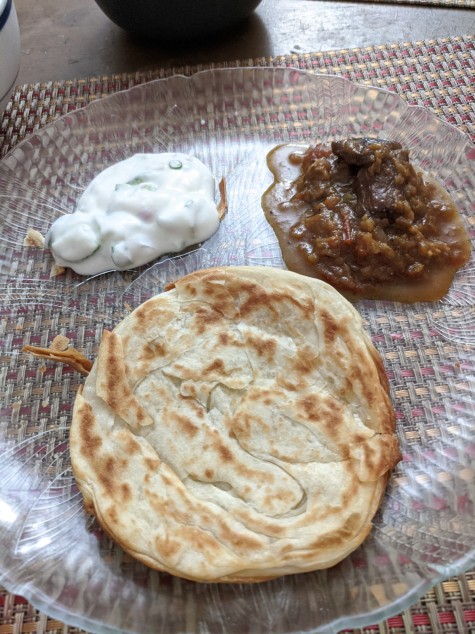
Here is what my mother emailed me years ago, for people who already have a general idea of how to cook Indian food. Below that I’ll add some additional tips and musings.
Beena’s Brinjal Curry
Ingredients:
- small brinjals (eggplants/aubergines) – 1/4 kg (works with big brinjals too)
- coriander powder – 2 tablespoons
- red chilli powder – 1 tablespoon
- salt to taste
- turmeric powder – 1 tsp
- small onions – 1/4 kg
- tomatoes – 1/4 kg chopped
- ground or grated garlic – 2 tablespoons
- curry leaves – a handful (8-12 leaves or more)
- tamarind pulp – 1/4 cup (A teaspoon of tamarind paste dissolved in a cup or two of water also works)
- black mustard seeds – 1/2 tsp
- black gram (urad dal) – 1tsp
- fennel seeds (somph) – 1/2 tsp
- cumin seeds (jeera) – 1/2 tsp
- fenugreek (methi) seeds – 1/4 tsp
- oil – 10 tablespoons
Steps:
- Wash the brinjals, slit lengthwise, and fry in half the quantity of oil. Set aside.
- Heat the remaining oil and fry mustard seeds, black gram dal, somph, jeera, and methi.
- Add onions, garlic, curry leaves, and tomatoes. Fry well.
- Add turmeric, salt, coriander, and chilli powder and fry till the raw smell goes.
- Add tamarind and 2 glasses of water.
- When the mixture boils add the fried brinjals and allow to thicken.
Tips!
Cutting the eggplant into big pieces rather than small ones is important here: if you use small pieces, a lot more oil gets absorbed. I recently discovered an alternative to frying. Just put the cut up pieces of brinjal in a bowl and mix with a few tablespoons of oil and salt. Then roast the pieces in the oven. I used a temperature of 350 degrees Fahrenheit. The goal is to get the skin nice and dark. While this is happening in the oven, you can move to the next step: making the ‘masala’ or spice mix.
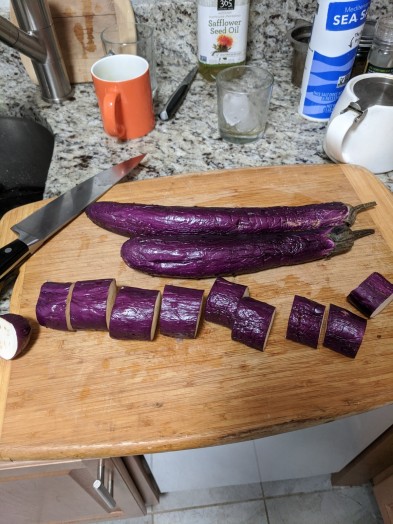
There is a basic technique that is common to many dishes from the Indian subcontinent: first extract flavour from the spices by frying them with onions, ginger and garlic, and then add the main ingredient: the veggies or meat. Making the masala is the most important step for getting a good flavour. And it takes time, so it’s not for people in a tearing hurry. But since the coronavirus is keeping so many of us at home, this time can be thought of as both cooking time and relaxation. I usually throw on some music. This time it was CCR. 🙂
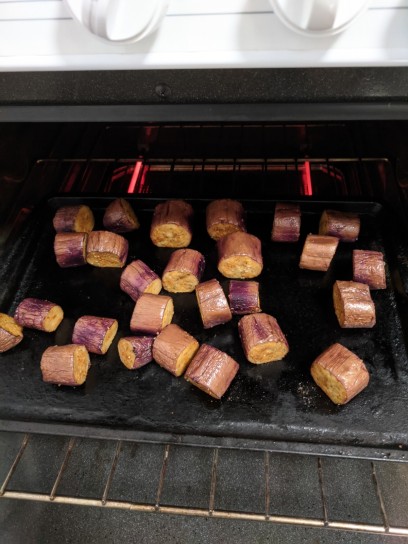
One thing I find fascinating about traditional cooking is the use of qualitative tests to determine when to do things. People without access to quantitative devices like thermometers or clocks can still create sophisticated recipes. Curry-making involves several steps that one can time “phenomenologically”. 😛
In your pot or wok, you start on high heat with oil and mustard seeds. When the oil is hot enough, the mustard seeds will start sizzling and popping. At this point, you can turn down the heat, and add the onions. The rest of the cooking can be done at medium heat. Here is where you add the other whole spices (the various seeds) and the urad dal. My ritual is to introduce ingredients one at a time so that they each get a few minutes as the ‘center of attention’. 🙂
Adding salt while the onions are frying speeds up the caramelization. Then you add the garlic, curry leaves, tomatoes, and powdered spices. If you don’t have whole fennel and cumin, you can use the powdered versions, and add them at this stage, with the turmeric, chilli, and coriander.
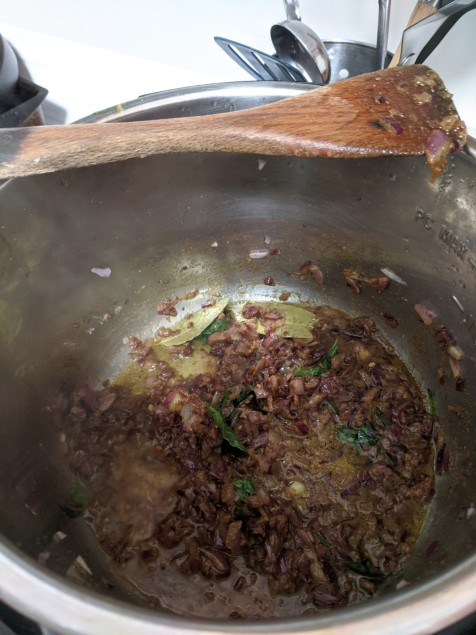
This is the stage where being patient helps. My mother says to fry “until the raw smell goes” — if you don’t already know what this smells like, it can be tricky. Whey spices are fully cooked, the powdery and raw smell changes to something subtly different. With experience, you’ll be able to tell. You can sometimes tell that this stage is reached by looking: the oil from the spices sometimes separates and floats on top of the cooking oil. In my experience this is usually hard to see. So you can keep frying at low to medium heat for around ten or fifteen minutes — the longer the better, as long as you don’t burn it. Keep stirring and remember to scrape the bottom of the pot. If the masala is getting stuck, keep adding small amounts of water to help with the scraping.
Once the masala has been fried well, add the tamarind. A teaspoon of sugar can be added at this stage to really bring out the tamarind taste (an idea I picked up from Vah Chef’s egg pulusu recipe on YouTube). I also add chopped green chillies here, for an extra kick. Finally, add the fried/roasted eggplant.
This time I cooked everything for ten minutes in the Instant Pot, but pressure cooking isn’t really necessary. You can let the curry thicken a little over a low flame, and then it’s ready to serve. I find that it goes really well with white rice and a classic yellow dal (lentils), and also with Indian flatbread.
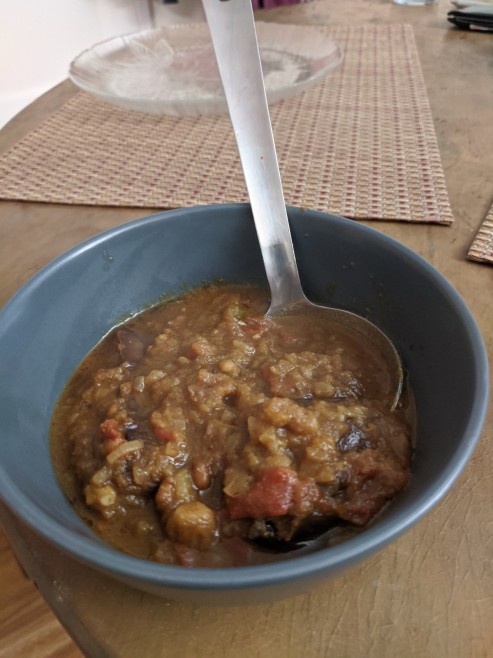
Also, don’t worry if you are missing some of the spices. You can make a pretty good Indian-style curry just with onions, garlic and/or ginger, coriander powder, cumin power, turmeric and chilli powder.
Enjoy!